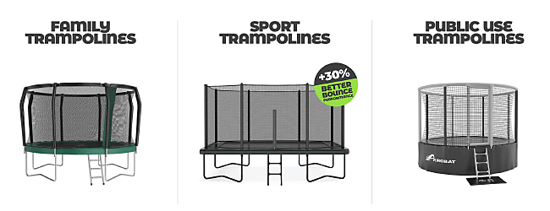Trampolines are an increasingly popular piece of sporting equipment, so it’s not surprising there’s a wide variety to choose from on the market. However, it’s important to keep in mind that not all trampolines offer the same level of safety.
For it to be safe, a trampoline has to undergo extensive testing to obtain the relevant safety certificate. But what exactly do safety certificates mean and how can you use them when buying a trampoline? Read on and find out!
Why are safety certificates important?
As a parent and trampoline user, you should know that trampoline safety certification is not compulsory. This means that a trampoline manufacturer doesn’t necessarily have to comply with them at all. However, safety standards mostly also determine the quality criteria, so it’s in the interest of manufacturers to achieve these criteria.
Decades ago, when we were still jumping on rusty trampolines, safety standards were not much discussed. Today, however, this is one of the key factors based on which we can say that trampolines are of high quality and safe for users. And what exactly should you look for in such certified products?

Ensure the trampoline was designed by an experienced manufacturer
The first step towards getting a safe trampoline is to choose a proven and world-renowned trampoline manufacturer. Although the low price of Asian trampolines may seem very tempting, the question is how long such a trampoline will last, along with its questionable safety.
By choosing a trampoline made by a reputable manufacturer, you are much more likely to get a safe piece of sporting equipment for your money. In addition to using the highest quality materials in their design, such trampolines are also subjected to numerous tests to ensure that they meet strict safety regulations.
Relevant safety certificate for your trampoline
Although safety standards for sports and other equipment are not a legal requirement, they certainly represent best practices in providing greater safety and preventing accidents.
Trampolines today thus have to satisfy a wide range of standards relating to padding or protecting the jumper from contact with springs, the frame, or any other hard surface. There is also a growing emphasis on product durability and specific requirements for quality frames, structural integrity, and UV resistance.
In this respect, it’s important not to overlook the following certifications for trampolines:
-
EN 71-14: This certificate defines all requirements and test methods. The certificate applies to trampolines for indoor and outdoor use, as well as those trampolines intended for use by one person at a time. By following the standards set out in the EN 71-14 certificate, it is ensured that these trampolines are safe for home use.
- EN 1176: The standard applies to permanently installed public playground equipment and surfacing. Its main purpose is to ensure adequate safety during play in, on, and around the equipment.
- EN 913: This is the standard that specifies the general safety requirements and test methods for all gymnastic and sports equipment intended for sports education, training, and competition – and we include trampolines in this category.
- EN 13219: This is the standard that specifies the functional requirements of certain types of trampolines and the specific safety criteria they must meet.
- REACH Regulation: Prevents the use of any raw material in the manufacture of trampolines that is hazardous to human health and the environment and lacks proper certification and traceability.
Make sure your trampoline is regularly inspected and maintained
Many safety regulations (EN 1176) also require trampolines to be regularly inspected and maintained in accordance with the manufacturer's instructions. In this respect, trampolines should be inspected on a daily, monthly, and annual basis.
If any defect or damage is found during the inspection, the trampoline must not be used until replacement parts have been obtained.
Our advice is to thoroughly research trampolines and their certification before purchasing one. You should also be aware that simply complying with the regulations will not automatically result in a safe trampoline, but that it’s equally important to use the sports equipment in accordance with the manufacturer's instructions for the model you have bought.

